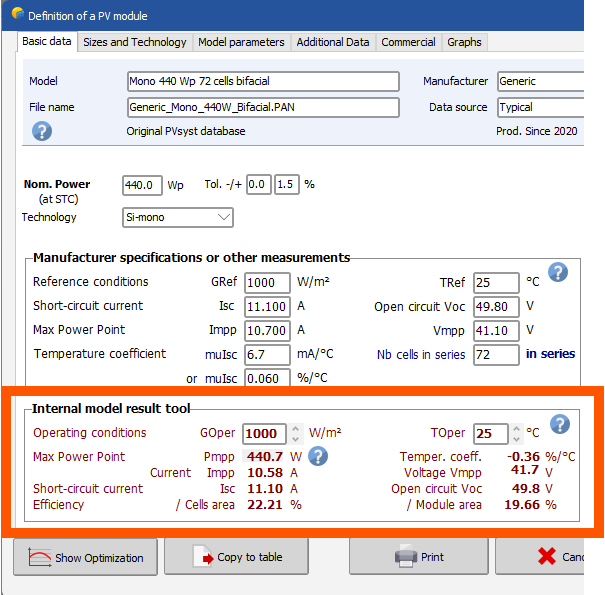-
Posts
785 -
Joined
-
Last visited
Everything posted by Michele Oliosi
-

Modeling two different module using One central Inverter
Michele Oliosi replied to mohsinsanaullah's topic in Simulations
@sauld no you are right, there could be some losses that would be missed by this approximation. Unfortunately this is a compromise, because currently MPPTs can only receive identical strings in the System definition in PVsyst. However for most cases these losses are rather small. The most important is the string to string mismatch (usually shading effects are even smaller because you need a very specific shading pattern for the multi-MPPT to help). You could add an estimate of these losses to the mismatch losses manually. You can estimate them using a tool found from Home window > Tools. There is a similar discussion here (see the last answer by my colleague Luca): -

How can i add the variable "EUseful" in the PVSYST report?
Michele Oliosi replied to Enzo Melgar's topic in Problems / Bugs
No currently only a partial selection of variables can be added as monthly tables. However EUseful is actually a composite variable, it is equal to other variables depending on the case. For example, here it should be equal to "Energy from the sun". -

PVsystCLI: Changing Simulation Parameters
Michele Oliosi replied to Gustavo Pianovski's topic in How-to
For most practical purposes, this is already available in the latest 8.0 version. Indeed, PVsystCLI has been made compatible with batch files. In other words, you can call a batch of simulations from PVsystCLI using a batch parameters file. You can find some more details on this page: https://www.pvsyst.com/help-cli/reference/index.html#run-simulation The command that you should look at is --batch-params-file -
@Yvano I see. Thanks for the clarification. Indeed, as mentioned by @André Mermoud the only way currently is to use the automatic attribution instead of the manual one to reach these overlapping modules. I will record this issue for future improvements.
-

Como añadir una variable en el informe de Pvsyst
Michele Oliosi replied to Enzo Melgar's topic in Problems / Bugs
Hi please make a new post in English or translate this one (including the title). Following the language rule will allow us to help more efficiently and also help other users 🙂 -

Decomposition and transposition models
Michele Oliosi replied to dina.christensen.martinsen's topic in Meteo data
Hi @James Barry Thank you for the feedback. This comes in very timeline as we are currently assessing models for the decomposition of irradiance from GHI for minute data. We are aware that diffuse fraction models such as Erbs can be biased when applied on sub-hourly scales. Providing an alternative to Erbs is thus a necessity. -
The simulation models both the location and the temperature, provided you have parametrized these properly. If the inverter malfunctions, you could also derate the inverter in PVsyst. Moreover, it is important to import the historical weather data corresponding to the monitoring period. Can you confirm whether you are using the corresponding time series for your simulation? If you are using a compatible time series as input for the simulation, it is then worth to compare the measured and simulated time series to understand whether the discrepancy correlates with any factor. Usually comparing the yearly PR and measured PR is not very telling per se. I think you should use the standard PR. However, it depends on how you are calculating the PR for the measured performance data. You should match the definitions of simulated an measured PR.
-

Differing POA Irradiance Depending on Weather Granularity
Michele Oliosi replied to JStief's topic in Simulations
Summarizing what we found with the data: the diffuse was not the same depending on the time granularity. This is likely a problem that the weather data provider should address. In PVsyst if the diffuse data is different, then the simulation results will be different. -
It is not in our most urgent priorities, but it is in our roadmap. Indeed, it would make the reverse transposition when importing POA data more reliable. However, to our knowledge, it does not address the bias inherent to applying the Perez model to sub-hourly data.
-

Differing POA Irradiance Depending on Weather Granularity
Michele Oliosi replied to JStief's topic in Simulations
Yes this is what I meant ! However, the differences seem to be small, I do not think they would account for the transposition difference. Another possibility that could exacerbate the effect of small GHI differences could be if DHI was not included in the file or not used at import ? Is there a chance you could send the weather data files (MET) or the raw data over to support@pvsyst.com? This would make the analysis a bit simpler. -
Glad to help ! I see, however I still fail to see the purpose of this request, sorry. If the inverter clips at a given time, this means that at that time the PV production reaches the clipping threshold at that time. If you model the PV production based on the measured data (not from a TMY), the clipping time should at least roughly correspond to the reality. Same thing with the module temperature, if you were to model using the real historical weather data, the temperature of the modules, measured and simulated, should at least roughly match. Let us know if I missed something about your intentions with the simulation.
-

Differing POA Irradiance Depending on Weather Granularity
Michele Oliosi replied to JStief's topic in Simulations
Dear JStief, This is puzzling, especially because PVsyst will average data to 1-hour steps anyway, meaning that the modeling should be identical. The first thing that springs to mind is that the 1-min, 5-min, and 60-min files are not simply related by averaging. In other words, if you average the 1-minute data, you won't obtain the 60-min data. Is there a chance to check that ? -
Hi, these two factors are directly related to the components in your system as well as the weather. Directly setting a clipping time or a maximum module temperature would be unrealistic, and is not possible in PVsyst. Instead, you can consider changing the components such as changing inverter model or PV module, or also changing the system layout.
-
Assuming that the statistics of the yield of a PVsyst are only influenced by the climate, as a first approximation, the PR will not change. This is because as a first approximation, the yield is proportional to the average irradiance (from which the climate variability is taken). However, at second order there will be other effects, that are too complicated to track down. Indeed, there is no definite definition of a P90 year useable for a simulation, only the statistical meaning that the yield should be better 90% of the times. I.e. you cannot exactly pinpoint whether this or that combination of entries in the time series has led to the reduction of the yield. However, since the very definition of P90 production also assumes a linear relation between irradiance and yield, it should be okay to consider the PR as constant.
-

Backtracking Management Assistance Required
Michele Oliosi replied to ASZulu's topic in Shadings and tracking
Hi, this is strange. NS axis trackers (whether 3D scene or using the “unlimited trackers” optimization) should work without issue. Can you send your project (use the export button in the project window to generate a zip archive with all necessary files) over to support@pvsyst.com ? Or share a snapshot of the disposition of your 3D scene. This will allow us to look into it further. -

Report shows spectral correction applied even when it isn't
Michele Oliosi replied to LauraH's topic in Problems / Bugs
Indeed, I confirm that this is the case and is quite misleading… and also not consistent with how PVsyst usually works. You should not be able to keep the spectral correction checked if it cannot be used for some reason. Thanks for this feedback @LauraH -
It depends on the layout of the strings in the field. We don't have a rule of thumb, but you could do something along these lines: you can make some simple assumptions concerning your field. For example, if your trackers are 2P (two in portrait), then you could assume that there are two strings per tracker, i.e. 1529 strings total. Then you could also assume that the trackers are roughly arranged in a square terrain, with GCR 0.4. And that modules are 1x2 m^2. Let's say x is the number of trackers on a single line along the axis and y is the number of rows. Roughly, y * 2 (# modules in table height) * 2m (module height) / 0.4 (GCR) = 24 (# modules in table length) * x * 1m (module width), i.e., y = 2.4 x. The total number of trackers is 1529 = y * x = 2.4 * x^2. Solving, that you get roughly x ~ 25 and y ~ 60. So 60 rows should be roughly it. Note that above 10-20 rows, the impact of the number of rows becomes quite small, so for systems of this size the exact values are not important at all.
-

Partition Definition in 3D Scene with 2-Portrait Trackers
Michele Oliosi replied to Alessia's topic in Shadings and tracking
We have calibrated the number of partitions based on the module layout calculation. Therefore, all these effects are taken into account in the partition model. The partition model per se is an approximation that will not always reflect the details of the electrical effect of partial shadings, but that should recover a plausible loss value for a long term (e.g. a year) simulation. However, for the case of the 2x14 structure, it should not be a partition that traces through the middle of the modules. That would be correct for the case 2T. Instead, this 2x14 structure is in the case 2TU, which has two partitions with size 1x14. -
Hi ! Which version are you using? I am asking this because in the current version this is not stated, as far as I know. The unlimited orientations do always include mutual shadings. The shadings calculation is inherent and is not related to choices in the "Near shadings" window. The number of rows (with the frenchism "sheds") is actually quite important for the evaluation of mutual shadings: it does affect simulation results.
-

Partition Definition in 3D Scene with 2-Portrait Trackers
Michele Oliosi replied to Alessia's topic in Shadings and tracking
Hi ! Yes, in general it is necessary to define partitions whenever you want to perform electrical shading calculations using the option "according to module strings". However, if you use the mode "Module layout" then the partitioning is not necessay as the submodule and structure is defined in the PAN file. No, in general the partitioning is not = to 1 string, sometimes you should count several partitions per string. For example, the half-cell parallel structure usually means doubling the number of partitions. You can find various examples here: https://www.pvsyst.com/help/project-design/shadings/electrical-shadings-module-strings/partition-in-strings-of-modules.html. Your cases are the 2TU and 2T respectively. -
Hello ! This is normal. Since there is very little irradiance as a total on the PV cells, the efficiency derate is on the low end of the curve that Luca showed. You also must take into account that the loss diagram is an average over many irradiance conditions (probably ranging between 0 and 200 W/m^2). Once you put everything together, the average loss of efficiency may well be 11% (below what you would get by just examining the loss of efficiency at (21 + 0.75*168.1) W/m^2.
-
UPDATE and correction to the previous answer. The "far" albedo (AlbInc, AlbHrz, AlbShd) and the "near" albedo (between PV rows, i.e. ReflFrt) should not be included in the same quantity to compare to POA measurements. The exception to this rule is the case of POA measurements that are made at the end of a row (such as in your case Luis). The problem with including both is that there is a risk of overcounting. For example in the case of a single row, AlbShd and ReflFrt do somwehat overlap. What this means is the following: if you measure POA away from the PV rows, or on the front row of the system, you can compare your measurements with GlobInc, or GlobHrz (which is like GlobInc but using the horizon profile as a shading). Between both, I'd rather use GlobHrz. Do not add ReflFrt. Instead, if you are measuring between the rows, the "far" albedo contribution should not be counted, and you should use ReflFrt instead. This means that you can compare to, e.g., GlobHrz - AlbHrz + ReflFrt. Note that if the POA measurement between rows is well below the top of the PV rows, then you should at least shade diffuse light, i.e., BeamHrz (horizon shaded beam) + CircHrz (horizon shaded circumsolar) + DiffShd (fully shaded diffuse) + ReflFrt (reflected irradiance between the rows). @Luis Zimmermann Sorry for the imprecise previous answers. This interaction between models is always a bit tricky. For your example, instead of BeamInc + CircInc + DifSInc + ReflFrt + AlbInc/2 + ( - HrzBLss - HrzCLss - HrzDLss - HrzALss/2) I would suggest now BeamInc + CircInc + DifSInc + ReflFrt/2 + AlbInc/2 + ( - HrzBLss - HrzCLss - HrzDLss - HrzALss/2)
-
BNPI conditions cannot be used as input in PVsyst. You could use the BNPI test report to re-evaluate the bifaciality factor. But per se the BNPI result will not be used in the simulation (in which irradiance and temperature conditions vary at every step). To calculate the bifaciality factor the approach would be as follows. The basic equation is Pmeas(BNPI) = P(1000+phi * 135), and solve for phi (bifaciality factor). This could be solved by trial and error using the PAN file interface to evaluate P(irradiance, 25°C), but it will involve manual steps. Once you find which irradiance yields P(BNPI), you can easily find phi.
-
Yes, actually the irradiance of front side + backside*bifaciality factor are put together, which gives an effective irradiance evaluation. Only after that, the PV conversion model applies. Indeed, the light reaches the same cells, be it from the front or the back. The same low-light performance is therefore taken into account for front and back (up to the bifaciality factor).


